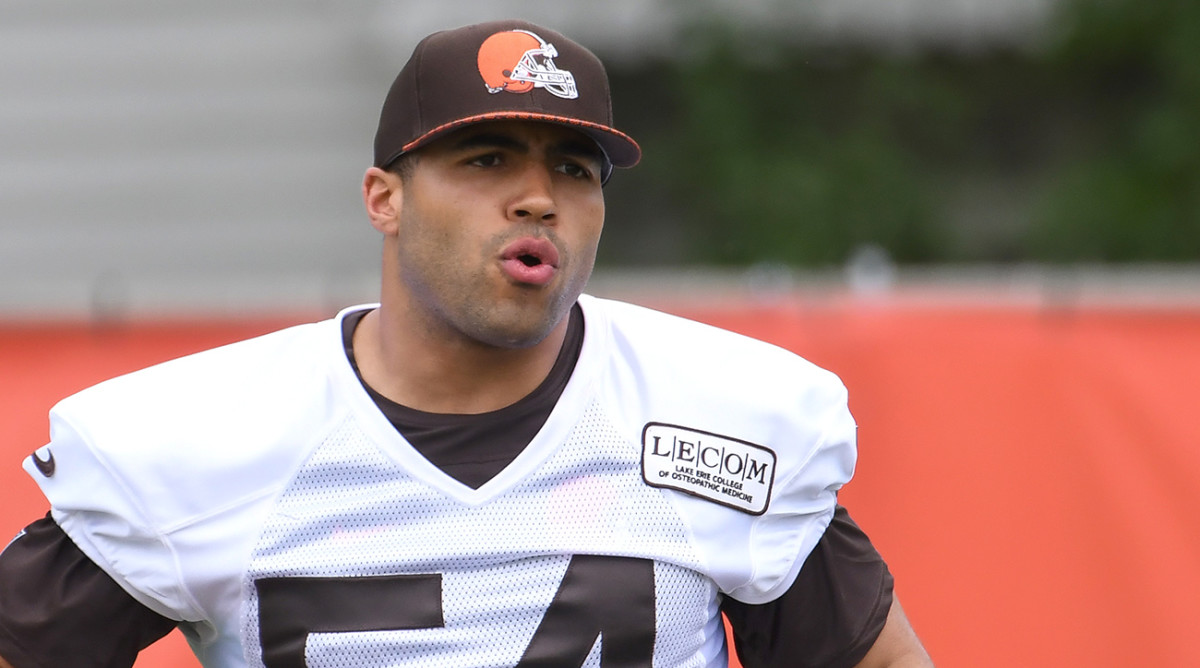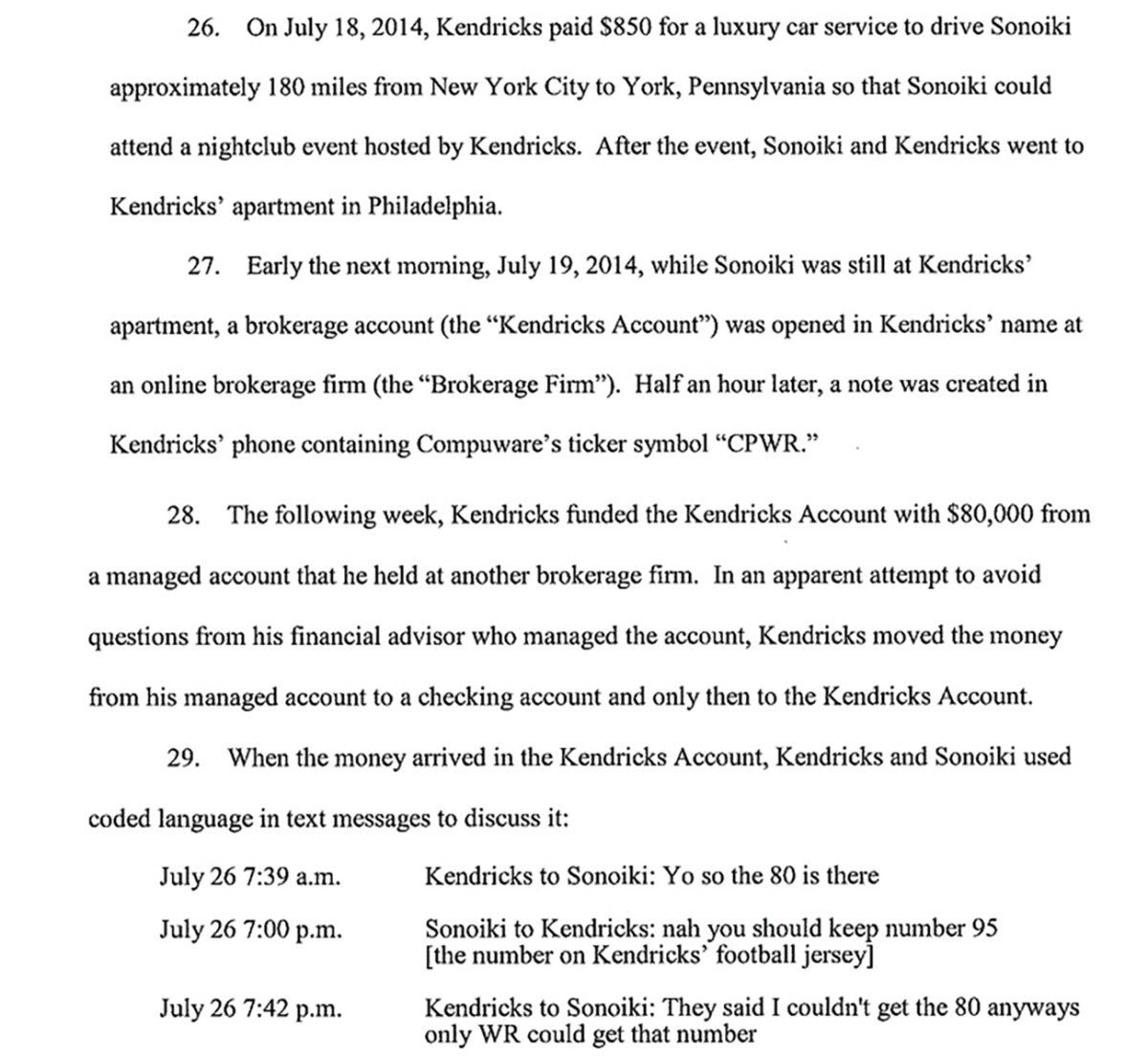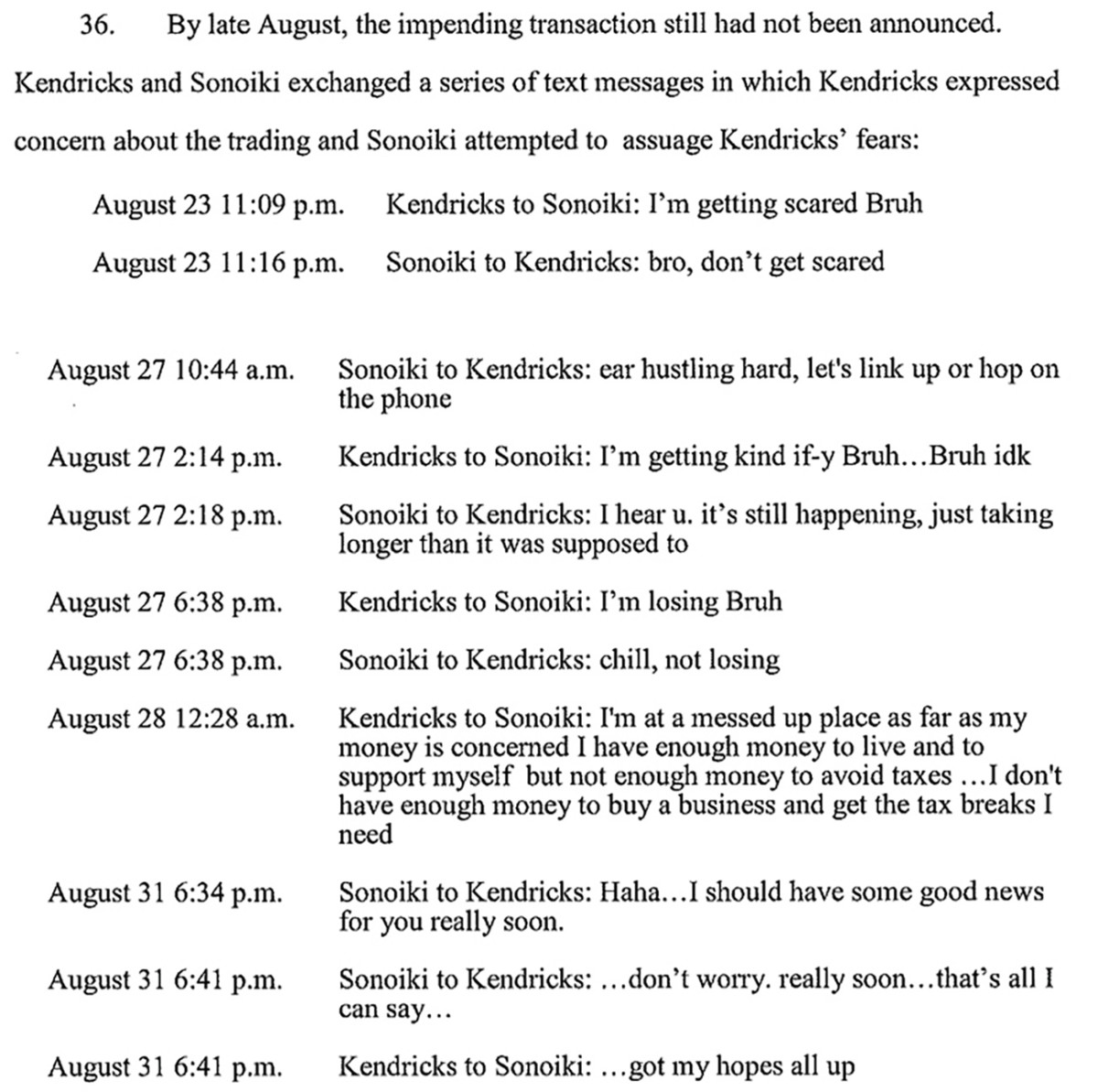Explaining the Insider Trading Case Against Mychal Kendricks

NFL linebacker Mychal Kendricks was charged on Wednesday with insider trading. According to U.S. Attorney William M. McSwain of the Eastern District of Pennsylvania, Kendricks and bank analyst Damilare Sonoiki conspired to design and advance a scheme whereby Sonoiki—who was also once a writer for the TV show Black-ish—delivered valuable non-public information to Kendricks. This information concerned upcoming investment bank mergers and insights as to how those mergers would impact the prices of publicly traded securities. This purported scheme occurred between July 2014 and March 2015, during which time the now-27-year-old Kendricks played for the Philadelphia Eagles. The Cleveland Browns, which had employed Kendricks since signing him as a free agent in June, reacted to Thursday’s developments by releasing the former Pac-12 defensive player of the year.
In a statement shared by Kendricks’s attorney, Michael Schwartz, Kendricks admits that he participated in insider trading. Kendricks also acknowledges that while he didn’t understand the details of his actions he nonetheless knew that his conduct was “wrong.” Kendricks’s statement also stresses that he is prepared “to accept the consequences” of his actions. In both tone and substance, such language signals that Kendricks is, at least in the abstract, willing to plead guilty to charges. Kendricks also claims that he didn’t “take any of the profits for himself”—though he doesn’t explain where the profits went.

The government’s case and the charges
To be clear, an apologetic statement attributed to Kendricks and shared on social media is not the legal equivalent of Kendricks standing before a federal judge and pleading guilty to crimes. While Kendricks’s statement indicates that he is fully cooperating, neither the Justice Department nor the Securities and Exchange Commission has issued a statement expressing the same sentiment. Just the opposite, actually, Christian Zajac, who is the Assistant Special Agent in Charge of the FBI’s Philadelphia Division, has issued a statement describing Kendricks’s acts as “not merely gaming the system” but instead as constituting behavior that poses “a threat to U.S. financial markets, because it compromises the public’s trust that our markets operate fairly.”
This discrepancy in tone is attributable to several possible factors, including that Kendricks and his attorneys are likely negotiating with the government as to where his cooperation and admission of wrongdoing will land him from a legal perspective—stated more bluntly, they are probably bargaining whether and to what extent Kendricks will serve time in prison and whether and to what extent Kendricks will pay monetary fines. Until any agreement is reached and Kendricks appears in court to plead guilty, the criminal case will continue.
With that in mind, McSwain asserts that Kendricks took the non-public information provided by Sonoiki and used it to purchase call options in companies that would, at future dates, be favorably impacted by mergers. This plot proved quite lucrative. After the mergers were announced, Kendricks sold the options for a combined profit of $1.2 million. As a related metric, the increase in price of the relevant options from the day Kendricks purchased them to the day he sold them ranged from 79% to 393%—an unbelievably spectacular range for a novice investor without access to non-public information. The Justice Department further alleges that Kendricks generously rewarded Sonoiki for his tips, giving him about $10,000 in cash, tickets to Eagles games, access to exclusive nightclub events and other items of financial and reputational value.
A criminal information brought by McSwain in the U.S. District Court for the Eastern District of Pennsylvania and an accompanying civil complaint brought by the U.S. Securities and Exchange commission in the same court offer substantial details of the alleged conspiracy. The complaint, for example, highlights the extent to which Kendricks and Sonoiki actively conspired:

Both Kendricks and Sonoiki now face three federal charges: conspiracy to commit securities fraud, securities fraud, and aiding and abetting. These are extremely serious charges. Although Kendricks, as a first-time offender, would likely not face anywhere near the maximum prison sentence, the crimes for which he has been charged carry up to a 25-year prison sentence. In addition to prison time, a potential penalty could include a three-year period of supervised release and a $5.3 million fine. Separately, the SEC has brought a civil complaint against both Kendricks and Sonoiki in the U.S. District Court for the Eastern District of Pennsylvania. The SEC demands that each defendant disgorge all ill-gotten gains and pay hefty fines.
Disturbingly for Kendricks, the federal government appears to have obtained a treasure chest of incriminating evidence. Both the information and complaint refer to numerous bank transactions and text messages. The government likely obtained this evidence through some combination of voluntary disclosures by witnesses and subpoenas. Such damning electronic evidence would be difficult for Kendricks to explain away in court. Consider the following exchange as revealed by the SEC’s complaint:

If no plea deal between prosecutors and Kendrick is reached, electronic evidence will become crucial to prosecutors in attempting to gain a conviction. Indeed, for prosecutors to prove that Kendricks engaged in insider trading, they must offer more than accounts of suspiciously timed transactions and unusually profitable purchases and sales. A conviction on insider training would require prosecutors show that Kendricks possessed the requisite mental state: an intent to deceive, manipulate or defraud. While Kendricks—who spent four years as a student-athlete at University of California, Berkeley, where his major was listed as social welfare—says that he knew what he was doing was wrong, it’s not clear if he would also say that he had an intent to deceive, manipulate or defraud. To that point, Kendricks’s admission of wrongdoing highlights his naïveté and dearth of sophistication on financial matters.
To the extent prosecutors possess the following forms of evidence, incriminating statements of witnesses as well as corroborating emails, audio conversations, transcripts, notes and other correspondences would each help prosecutors establish that Kendricks received and unlawfully acted on confidential tips from Sonoiki. Also, if evidence tends to show that Kendricks engaged in what’s known as “conscious avoidance”—that is, taking measures to appear ignorant of wrongdoing when the wrongdoing was obvious to him—prosecutors could more persuasively show that Kendricks possessed the requisite intent.
John Elway’s Comments Could Prove Problematic for the NFL in Colin Kaepernick’s Collusion Case
The roles of cooperating witnesses, unindicted co-conspirators and the ‘Prisoner’s Dilemma’
Given that the bank transactions in question involved multiple persons, it is possible that that federal authorities have already obtained key testimony from cooperating witnesses. Such witnesses may be inclined to implicate Kendricks and Sonoiki in order to avoid being charged themselves. To that point, the criminal information refers to “Person#1.” This is a person with whom Sonoiki allegedly communicated with “as a buffer to provide non-public information regarding Investment Bank clients to Kendrick . . . Person#1 then used that information to make trades on behalf of Kendricks.” Person#1 is also accused of conspiring with Kendricks to make “small, legitimate trades in Kendricks’s” account in order to “mask the success of the trades that they made based on non-public information provided by Sonoiki.”
Given Person#1’s apparently instrumental role in the transactions, it stands to reason that the government may have approached him or her with threat of facing charges unless they cooperate. Such “cooperation” means that a witness is willing to provide sworn testimony that implicates himself/herself as well as the defendants. The cooperating witness usually must also turn over texts, emails, bank statements and other relevant records. Alternatively, it is possible that Person#1 is viewed by federal authorities as an unindicted co-conspirator who could later be charged unless they cooperate (or unless they continue to cooperate).
This same sort of dynamic is likely also true for the co-defendant relationship between Kendricks and Sonoiki. When the federal government charges multiple persons in the same conspiracy, often prosecutors attempt to negotiate plea deals with some of the conspirators—especially those conspirators whose conduct is comparatively less blameworthy and especially those who possess crucial information to help prosecutors convict other members of the conspiracy. Kendricks’s statement seems to frame Sonoiki as taking advantage of his naïveté. “I invested money with a former friend of mine who I thought I could trust and who I greatly admitted,” Kendricks laments. “His background as a Harvard graduate and an employee of Goldman Sachs gave me a false sense of confidence.”
As to the relevance of the “prisoner’s dilemma,” it refers to a situation in which each conspirator believes that if each remains silent, none will be convicted. Yet each also realizes that if any of the conspirators “talk”— cut a deal with the government—the others are more likely to be convicted. Kendricks’s apparent cooperation with the government signals that he appears willing to cut a deal and in turn implicate Sonoiki. Whether Sonoiki is doing the same with prosecutors and point the finger at Kendricks is unknown. However, that possibility is surely a concern for Kendricks and his legal team. There may be a rush to cut a deal.
Impact on Kendricks’s NFL career
Without a doubt, the most serious worry for Kendricks regarding the insider trading charges is whether he will be going to prison and, if so, for how long. Much farther down the list is whether the charges will end, or at least extensively interrupt, his NFL career. The immediate consequence for Kendricks, who in June signed a one-year contract with the Browns worth up to $3.5 million, was that Cleveland informed him that he would not play for the team this week. Shortly after Kendricks was charged, the team announced that he would not travel with the team to Detroit on Thursday for the preseason game against the Lions. On Thursday evening, the Browns announced that they had cut ties with Kendricks altogether and released him.
Both the Browns and NFL are relevant stakeholders for Kendricks’s future in the league. Kendricks’s admission to wrongdoing, albeit not in the form of a courtroom plea, gave the Browns reason to swiftly terminate Kendricks’s contract. The standard NFL player contract contains several clauses that empowered the Browns to lawfully end their relationship with Kendricks. For instance, Paragraph 2 requires that a player “conduct himself on and off the field with appropriate recognition of the fact that the success of professional football depends largely on public respect for and approval of those associated with the game.” Further, Paragraphs 9 and 11 permit teams to terminate the contract of a player whose “personal conduct [is] reasonably judged by club to adversely affect or reflect on club.” Kendricks openly admitting that he engaged in insider trading clearly gave the Browns a legitimate reason to cut him.
The Browns could have elected to take on a more forgiving approach to Kendricks. The team might have placed emphasis on the fact that Kendricks took ownership of his mistakes. Also, it doesn’t appear that the charges came as a complete shock to the Browns. The Associated Press reports that the Browns were aware in June when they signed Kendricks that there was an ongoing insider trading investigation connected to him. The Browns, however, apparently didn’t know that federal authorities viewed Kendricks as a target of the investigation. It’s unclear why the Browns came to this favorable belief of Kendricks when the linebacker now freely admits he engaged in wrongdoing (it’s possible that Kendricks has simply changed his account between what he told the Browns in June and what he now admits to).
The NFL could also rely on the combination of serious felony charges and Kendricks’s admission to suspend Kendricks. Article 46 of the collective bargaining agreement empowers commissioner Roger Goodell to punish players “for conduct detrimental to the integrity of, or public confidence in, the game of professional football.” Goodell has used this vague language to punish players for a wide-range of misconduct. He could clearly do so with Kendricks.
Alternatively, Goodell might wish to wait to see how the Kendricks’s legal situation develops before suspending him. Goodell could appreciate that Kendricks, a second-round pick of the Eagles in the 2012 NFL draft, appears interested in reaching a plea deal with prosecutors and accepting responsibility for his misconduct. The NFL could wait to punish Kendricks until there is a conclusive resolution in his criminal case. At the same time, Goodell might worry about the optics of permitting the continued eligibility of a player who just admitted to insider trading, at least as far as Kendricks understands that term. To reconcile these perspectives, Goodell could place Kendricks on the “Exempt List,” which is essentially administrative leave or a paid suspension. The list, which is not defined in the CBA but instead in the NFL Player Personnel Policy Manual, would forbid Kendricks from showing up to work but the Browns would still pay him (assuming the Browns don’t cut or suspend him).
Lastly, the NFL might question the Browns as to the extent to which the organization engaged in due diligence before signing Kendricks. If the Browns learned of the federal investigation, but only relied on a depiction of the investigation as told by Kendricks or his agent, the league might question whether the team should have done more digging. Did the team attempt to speak with persons connected to Kendricks before signing him? Likewise, the NFL may probe the Eagles as to the organization’s awareness of Kendricks’s legal issues and what steps, if any, the team took in response. These are topics that the league likely has significant interest in.
Michael McCann is SI’s legal analyst. He is also Associate Dean of the University of New Hampshire School of Law and editor and co-author of The Oxford Handbook of American Sports Law and Court Justice: The Inside Story of My Battle Against the NCAA.
